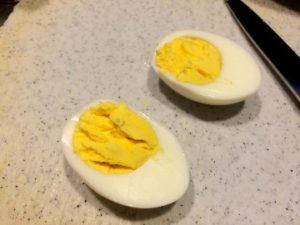Steaming eggs for Hard boiled results
For the most evenly cooked, tender hard boiled eggs, forget the boiling water, use a steamer instead.
Why this recipe works:
Placing eggs into a pot full of steaming water cooks them evenly and gently with less risk of cracking than dropping them into simmering water.
Chilling the eggs immediately after boiling ensures that they come out perfectly shaped with no air space indentation on their fat end.
Starting the eggs hot and peeling under running water makes for easy, divot-free peeling almost every time.
Perhaps the most common problem with hard-boiled eggs is overcooking. That’s what happens when the yolks are pale yellow with that familiar green band around the outside. There is frequently the odor of sulfur.
This is due to a reaction between traces of iron in the yolk and sulfur in the white. It happens only when eggs have been overcooked. Perfectly cooked yolks are moist and deep orange. Needless to say, there is no chemical smell.
The second biggest problem is cracked shells that leak yolk and white out into the cooking water. This is caused by too-rapid heating. All eggs contain an air pocket at the base (the wide, rather than the pointed, end). When the air pocket is heated, it expands. If it is heated too quickly, it more like explodes, cracking the shell.
So what is the best way to get a hard-boiled egg? The answer: Steaming!
| Servings | Prep Time |
| 6people | 5minutes |
| Cook Time | Passive Time |
| 18minutes | 20minutes |
|
|
Ingredients
- 6 eggs
Instructions
Steaming
- Place steamer basket in the bottom of your usual egg-boiling pot. and then add water until it begins to barely come up through the bottom of the steamer. (You want enough water in the pan so that you can boil for 15 to 20 minutes.)
- Add eggs to basket and cover the pan with a lid. Bring water to a boil then turn down the heat and simmer for 15-20 minutes. (depending on how “hard” you want them)
- Remove from heat and fill pan with cold water to stop the cooking process. (I add ice cubes to facilitate quicker cooling) You will find that they are exceptionally easy to peel, not only right after steaming. But after days in the refrigerator as well.
Peeling
- Why steamed eggs are easier to peel. Egg shells are permeable, which means that they are porous. The water molecules that the steam form are small enough to penetrate the shell. While the don’t disrupt the membrane, the heat from the steam is adequate enough to cook the egg inside. Start with cracking the large end of the egg and peeling off the cracked shell. This will expose the air bubble that forms naturally on that end of the egg.
- Then peel down the side of the by cracking small chunks of the shell away. Remember to go past the small end of the egg.
- Now you should be able to pull one side of the remaining shell off in a large chunk.
- Repeat on the other side.
Recipe Notes
Now you have a perfectly steamed egg!
(you may have to try different steaming times to find out what works for your situation)
